Assessment of diaphragmatic thickness as a predictor for intubation in pneumonia patients
All claims expressed in this article are solely those of the authors and do not necessarily represent those of their affiliated organizations, or those of the publisher, the editors and the reviewers. Any product that may be evaluated in this article or claim that may be made by its manufacturer is not guaranteed or endorsed by the publisher.
Authors
Pneumonia, one of the major contributors to morbidity and mortality globally, often leads to serious complications such as respiratory failure. Diaphragmatic dysfunction, detected through ultrasound, may predict the need for intubation in patients with pneumonia. This study aimed to evaluate the roles of diaphragmatic thickness fraction (DTF) and diaphragmatic excursion (DE) as predictors of intubation in pneumonia patients. This follow-up cohort study involved 53 participants diagnosed with pneumonia. Diaphragmatic ultrasonography was performed to measure DTF and DE within 24 hours of admission. The mean age of the patients was 51.8±20.4 years, with 66% being male. Diabetes mellitus (DM) (p=0.000) and hypertension (HTN) (p=0.003) were significantly associated with the need for intubation. DE was significantly correlated with intubation (p=0.001). At a cut-off of 2.9 cm, DE demonstrated 100% sensitivity and 56% specificity for predicting intubation. DTF exhibited 92% sensitivity and 60% specificity at a cut-off of 0.52, with a positive predictive value of 85% and a negative predictive value of 54%. Diaphragmatic parameters, particularly DE and DTF, are significant predictors of intubation in pneumonia patients. Comorbidities such as DM and HTN also play a critical role, underscoring the importance of early identification of high-risk patients for timely intervention.
Ethics approval
This study was done in Helwan University Hospitals from July 2023 to July 2024, following approval from the Institutional Review Board of Helwan University and the Chest Department, Helwan, Egypt. Approval No.: 91-2023).How to Cite

This work is licensed under a Creative Commons Attribution-NonCommercial 4.0 International License.






